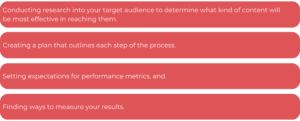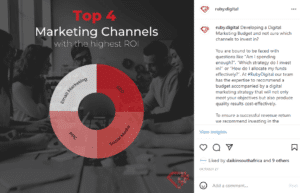Content marketing has become an important aspect of any business or organisation’s marketing strategy. From websites and blogs to videos and social media, businesses have started to understand the importance of content in building relationships with their customers and engaging potential buyers.
As we move closer to 2023, it’s more important than ever for digital marketers to incorporate content into their future strategies. But what does successful content marketing look like?
In this blog post, we’ll explore the best practices for crafting a winning content marketing strategy for your business that will help you engage more customers and generate more leads. We’ll also examine the different types of content marketing, discover how to set content marketing goals, and measure your success with the most relevant KPIs for your brand.
We’ll discuss ways to come up with creative ideas, choose the right channels for your posts and ads, set achievable goals, and generally get the most out of the content you create. If you want to learn how to craft a powerful content marketing plan that will catapult your brand into 2023 and beyond, then let’s get started!
Content marketing definition
Firstly though, what is content marketing? Content marketing is a term used to describe a range of promotional techniques used by companies to communicate with potential customers. This involves creating and distributing content – such as text, videos, graphics, podcasts, blogs and even webinars – that help to build trust in a brand and provide useful information.
Digital content marketing works on the basis that if customers are provided with valuable information without being asked for anything in return, then they will become more likely to purchase a product or avail of a service when needed. By engaging customers with quality content tailored to their interests, companies can effectively open up dialogue and form deeper relationships with them.
In short, content marketing is a strategy for engaging current and potential customers with top-notch content relevant to their lives. It’s an approach focused on delivering value first, rather than sales. When done well it can result in genuine interest from qualified leads and ultimately increased revenue for businesses of all sizes.
SEO content marketing takes this approach one step further by also focusing on the use of search engine optimisation (SEO) techniques in order to raise the visibility of the content you create in search engine results pages (SERPs). By optimising titles, descriptions, keyword usage and other aspects related to SEO, you can help your content rank higher in search results than competitors. With strategically crafted SEO-friendly content, businesses can maximise their potential for organic lead generation and potential customers.
How is content marketing different to blogging?
Blogging is a great way to engage and inform your audience, but content marketing takes things a little bit further. Content marketing involves creating content with the aim of attracting, engaging, and converting customers. It focuses less on simply creating editorial pieces and more on providing educational and shareable information, such as e-books, case studies and videos.
Content marketing also involves more strategic planning than blogging, often requiring specific types of content that cater to an identified customer journey or funnel. The purpose of this is to provide valuable information that will help lead customers towards conversion or other desired actions.
Ultimately, successful content marketing requires careful planning, analysis, and ongoing optimisation to track results and adjust campaigns accordingly. When done correctly it can be an incredibly effective way to reach your target audience on a deeper level than traditional blogging alone can offer.
Why is content marketing so important?
The potential benefits of content marketing speak for themselves here:
- Content marketing is an effective way to reach a target audience and build relationships with them.
- Content marketing can help businesses increase their brand awareness.
- Content marketing can lead to more website traffic and increased sales.
- Content marketing is a cost-effective way to promote a business.
- Content marketing can help generate leads, build trust, and increase customer loyalty.
- Content marketing can help position a business as an industry expert or thought leader.
- Content marketing is a great way to create meaningful connections with customers and prospects alike.
- Content marketing can enhance SEO performance and drive more organic search traffic to your website.
- Quality content helps differentiate a business from its competitors in the eyes of prospective customers.
- Good content helps to establish a positive reputation and lasting relationship with customers that will keep them coming back again and again for more.
What is a content marketing strategy?
As we’ve discussed, content marketing involves the creation and distribution of high-quality, consistent, and targeted content to a specific target audience with the purpose of achieving specific business objectives. A content marketing strategy is how you plan on using this type of marketing to achieve your goals.
It requires:

This strategy should also include ongoing optimisation efforts such as regularly evaluating data analytics so you can adjust it to stay current with changing trends or customer needs. Lastly, having a clear understanding of who owns the strategy and incorporating feedback from all stakeholders are key components in developing a successful content marketing strategy. By taking these steps, you’ll be well on your way to creating an effective plan for communicating with your customers through meaningful content.
The different types of content marketing
While most people think content marketing only involves long-form posts or guides, the truth is that content can take many forms. For instance, blogs and websites are both viable methods for delivering content created with the goal of engaging consumers. Similarly, paid online ads, podcasts, videos, and even images such as infographics all play important roles in content marketing.
Social media can also be a great platform to disseminate information in an entertaining and engaging way. Content marketing provides brands with the opportunity to let their identity shine through while building relationships with their target audiences. There’s no right or wrong content when it comes to effective marketing – instead, it pays to research different mediums to find out which works best for your brand.
What do you need to consider when creating your content marketing strategy?
Next up, we’ll look at some best practices for content marketing.
#1 – Bear Google’s algorithms in mind
Creating a successful content marketing strategy requires careful consideration. Firstly, it’s important to bear Google’s algorithms in mind – the concept of E.A.T (Expertise, Authoritativeness and Trustworthiness) is highlighted in Google’s Search Quality Guidelines, and is something to be aware of when crafting your copy. After all, you want it to rank well so people can actually find it!
Additionally, you should try to focus on creating content that is both updated regularly and helpful for those reading it. Keep mindful of formatting styles too – modern web users are more comfortable with shorter sentences and bulleted lists than ever before; readable text that launches straight into the topic can make all the difference.
Further, articles or blog posts should provide factual information written by knowledgeable authors in order to ensure people get value out of their time spent reading it. Following these points carefully will enable you to craft a compelling content marketing strategy that will engage your audience and improve your rankings in the search engine results pages over time.
#2 – Define what you’re trying to achieve
What is your end goal? Content marketing can be an effective way to reach your target customers, but it’s important to have a clear mission statement before you get started.
- First, set a goal for what you want to achieve – do you want to educate your audience on the product or industry? Or are you focused on developing a sales funnel? Maybe you’re looking for ways to showcase thought leadership in your field.
- Once you’ve answered this question, it’s time to craft a mission statement that outlines exactly what content needs to be created and why. This will help ensure that all of your content is focused and cohesive.
- Next, set measurable goals and KPIs (Key Performance Indicators) so you can assess how well you’re doing, what is and isn’t working, and which types of content resonate best with your audience.
- Finally, think about the specific action that you want your audience to take after consuming the content. Are they supposed to submit a lead or sign up for updates in return for a resource? Whatever the action, make sure your content marketing funnel points them towards it.
Asking and answering these questions will give you direction when creating your content marketing mission.
#3 – Define your audience
Knowing who your content is intended for is crucial in crafting a successful, engaging message. You’ll want to define your audience early on, especially if you’re creating content that will be seen by many different people.
Think about the demographic or audience you are marketing to and develop an understanding of their preferences and needs. Is your content aimed at a younger generation? If so, they may respond differently than older generations to certain topics or certain types of language.
Consider the platforms that these people are using, too – some may be more active on certain channels than others. Once you get a better idea of who you are talking to, you will have an easier time understanding the type of content that is most likely to resonate with them. With careful consideration given to who your target audience is, it’ll be much easier to produce content tailored just for them!
#4 – Plan your process
Make it clear exactly who is responsible for what, so everyone on your team knows what is expected from them. With specific tasks laid out, like who will create content and by when, it’s easier to hold yourself and other members of the team accountable.
It’s helpful to draw up a schedule listing each task and its due date, as well as any notes about who will be responsible for them. Additionally, be sure to include in your plan the why – explain why the content matters and how it contributes to achieving the overall goal. By planning this way beforehand, you can ensure every step along the way helps drive your brand forward.
#5 – Do your research
Before work on a piece of content begins, do some keyword research to get a better grip on what kinds of information people are searching for. This achieves two things simultaneously: it gives your content a better chance of being found in relevant searches, and it also informs you about the specific questions the public has about your area of expertise.
During this process, look for all four types of keywords – navigational, informational, investigational, and transactional – as this will help you tailor your content better for your ideal audience.
Topic research is also important – make sure you have a good understanding of the broader topic as well as the more specific nuances.
#6 – Make sure your content is SEO friendly
Content that’s optimised with the right keywords, titles, and descriptions will get more visibility, boost conversions, and drive organic traffic. That’s why paying attention to SEO-friendly content is so important.
Ensure your data is correctly tagged with keyword-rich title tags and meta descriptions which can help search engines like Google easily discover your content – this makes it easier for users to find you on the web. Additionally, interlinks between various pages help with indexing and boosts user satisfaction.
Last but not least, using header titles such as H1 and H2 throughout your page can make your site look organised and professional while helping Google understand the structure of each page. The details matter when it comes to SEO friendly content – taking care of these small things can vastly improve your content’s credibility as well as its ranking in SERPs.
#7 – Promote your content
Promoting your content can be one of the most important aspects in creating successful digital content marketing campaigns. It’s essential to know where the best place to promote your content is, so you can reach the right people who will be interested in engaging with it.
The answer depends on you and your target audience – certain platforms such as LinkedIn, Facebook or Twitter may be better for some brands than others. You should also consider setting up an email list, so that you can reach out to people who have already expressed interest in what you have to offer.

Researching relevant blogs and influencers in your industry is another great way to spread the word about your work. By choosing the right approach for promoting your content, you’re sure to get a better response from your target audience!
#8 – Repurpose your content
By transforming existing content into different formats, you can create multiple pieces of content from the same source material. For example, if you have a podcast episode on your business’s current initiatives, you could record the conversation as a video, or publish written highlights from the conversation as a written guide.
You could then use additional data points to piece together an infographic about the episode topic, which can in turn be shared on your social media pages. Finally, don’t forget to promote your newly repurposed content with high-impact visuals across all your channels. Content repurposing is a smart way to get maximum ROI out of content while maximising reach and engagement.
#9 – If possible, use User Generated Content
User-Generated Content (UGG) is content created by non-professionals (like your customers) and shared with an audience, such as reviews, videos, blogs, photos, testimonials, etc. It can be a powerful tool for any business or individual looking to spread their message.
Not only does it establish credibility and trust by providing factual, unsponsored information about a product or service, but it also helps to create a sense of connection between the company and its audience. User generated content can be an invaluable asset when it comes to driving traffic and engagement – so leverage it if you possibly can.
#10 – Measure your content’s effectiveness
There are a number of tools that can help with this – from Google Search Console and Google Analytics, which track user engagement on your website, to event tracking for keeping track of desired outcomes (such as clicks, purchases and downloads).
This data can hold invaluable information regarding which pieces of content are producing the ultimate goal set out by your specific goals and KPIs. By understanding what works better than other pieces of content, you can adjust future strategies to ensure maximum returns, as well as getting a step ahead of your competitors with the latest content marketing trends.
All in all, using metrics for measuring your content’s performance is an essential part of any successful content marketing strategy. It takes time to build a powerful arsenal of tracking tools that you can rely on, but the results are worth it. Investing in effective measurement systems will help take your content marketing efforts to the next level.
If you need help with any of the SEO content marketing techniques we’ve discussed today, we’d love to hear from you! Ruby Digital offers impactful, results-driven and cost-effective content marketing strategies for businesses of all types and sizes. Reach out today to find out more.




